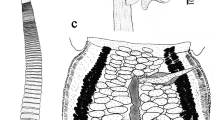Abstract
Potamotrygonocestus Brooks & Thorson, 1976 is currently represented by six recognised species of tetraphyllidean cestodes inhabiting Neotropical freshwater stingrays. Potamotrygonid stingrays examined to date have included only a single specimen of Plesiotrygon iwamae. Only one species of tetraphyllidean, Potamotrygonocestus chaoi Marques, Brooks & Araujo, 2003, has been described from this host, and this description was based on limited material. New efforts to document the diversity in this host species resulted in the collection of eight additional specimens of P. iwamae, one of these from the upper Rio Solimões, at São Paulo de Olivença Amazonas during September, 2003, and seven from the Baía do Marajó, Pará, during November, 2003. The specimen from the upper Solimões was found to be infected with P. chaoi. Voucher material from this stingray was used for the redescription of this cestode, which is characterized by strobila 8.78–22.83 mm long and a great number of proglottides, 58–93; the new material provided strobilar length and proglottis counts for complete worms. Potamotrygonocestus marajoara n. sp. is the second species of this genus reported from Plesiotrygon iwamae, although it appears to be restricted to the lower Amazon. This new species resembles P. chaoi in possessing filitriches and blade-like spinitriches on the scolex, cephalic peduncle and cirrus, but differs from other species of the genus in the number of testes, which is 44 on average per proglottis, and by having apical sucker measuring 95–175 μm in length. Additional data on the distribution and morphology of the microtriches and a detailed description of the female reproductive system are also provided in this study.





Similar content being viewed by others
References
Brooks, D. R., Mayes, M. A., & Thorson, T. B. (1981). Systematic review of cestodes infecting freshwater stingrays (Chondrichthyes: Potamotrygonidae) including four new species from Venezuela. Proceedings of the Helminthological Society of Washington, 48, 43–64.
Caira, J. N., Jensen, K., & Healy, C. J. (1999). On the phylogenetic relationships among tetraphyllidean, lecanicephalidean and diphyllidean tapeworm genera. Systematic Parasitology, 42, 77–151.
Caira, J. N., & Jensen, K. (2001). An investigation of the co-evolutionary relationships between onchobothriid tapeworms and their elasmobranch hosts. International Journal for Parasitology, 31, 960–975.
Caira, J. N., & Orringer, D. J. (1995). Additional information on the morphology of Potamotrygonocestus magdalenensis (Tetraphyllidea: Onchobotriidae) from the freshwater stingray Potamotrygon magdalenae in Colombia. Journal of the Helminthological Society of Washington, 62, 22–26.
Caira, J. N., & Tracy, R. (2002). Two new species of Yorkeria (Tetraphyllidea: Onchobothriidae) from Chiloscyllium puntatctum (Elasmobranchii: Hemiscyllidae) in Thailand. Journal of Parasitology, 88, 1172–1180.
Euzet, L. (1959). Recherches sur les cestodes tetraphyllides des selaciens côtes de France. Thesis, Université de Montpellier, 263 pp.
Fyler, C. A. (2007). Comparision of microthrix ultrastructure and morphology on the plerocercoid and adult scolex of Calliobothrium cf. verticillatum (Tetraphyllidea: Onchobothriidae). Journal of Parasitology, 93, 4–11.
Hoberg, E. P., Sims, D. E., & Odense, P. H. (1995). Comparative morphology of the scolices and microtriches among five species of Tetrabothrius (Eucestoda: Tetrabothriidae). Journal of Parasitology, 81, 475–481.
Ivanov, V. A. (2004). A new species of Rhinebothroides Mayes, Brooks & Thorson, 1981 (Cestoda: Tetraphyllidea) from the ocellate river stingray in Argentina, with amended descripitions of two other species of the genus. Systematic Parasitology, 58, 159–174.
Jensen, K. (2001). Four new genera and five new species of lecanicephalideans (Cestoda: Lecanicephalidea) from elasmobranchs in the Gulf of California, Mexico. Journal of Parasitology, 87, 845–861.
Marques, F. P. L., & Brooks, D. R. (2003). Taxonomic revision of Rhinebothroides (Eucestoda: Tetraphyllidea: Phyllobothriidae), parasites of Neotropical freshwater stingrays (Rajiformes: Myliobatoidei: Potamotrygonidae). Journal of Parasitology, 89, 994–1017.
Marques, F. P. L., Brooks, D. R., & Araújo, M. L. G. (2003). Systematics and phylogeny of Potamotrygonocestus (Platyhelminthes: Neodermata: Eucestoda: Tetraphyllidea: Onchobothriidae) with descriptions of three new species from freshwater potamotrygonids (Myliobatoidei: Potamotrygonidae). Zoologia Scripta, 32, 367–396.
Page, R. D. M., & Charleston, M. A. (1998). Trees within trees: Phylogeny and historical associations. Trends in Ecology and Evolution, 13, 356–359.
Richmond, C., & Caira, J. N. (1991). Morphological investigations into Floriceps minacanthus (Trypanorhyncha: Lacistorhynchidae) with analysis of the systematic utility of scolex microtriches. Systematic Parasitology, 19, 25–32.
Ruhnke, T. R., Caira, J. N., & Carpenter, S. D. (2006). Orectolobicestus n. g. (Cestoda: Tetraphyllidea), with the description of five new species and the transfer of Phyllobothrium chiloscyllii to the new genus. Systematic Parasitology, 65, 215–233.
Wilcox, D., Dove, B., McDavis, D., & Greer, D. (1995–2002). Freeware distributed by http://ddsdx.uthscsa.edu/dig/dowload.html.
Williams, H. H. (1968). The taxonomy, ecology and host-specificity of some Phyllobothriidae (Cestoda: Tetraphyllidea), a critical revision of Phyllobothrium Beneden, 1849 and comments on some allied genera. Philosophical Transactions of the Royal Society of London, Biological Sciences, 253(786), 231–307.
Acknowledgements
We are grateful to Eduardo Tadeu de Matos and Lara M. Guimarães for their assistance with SEM and to Ênio Mattos for help with SEM and histological work. The authors are thankful for partial support from the IBAMA - PNUD BRA/00/008/ strategic study “Bases Científicas para a conservação da Várzea: identificação e caracterização de regiões biogeográficas (PROVARZEA/MPEG/FADESP)”, and in particular to Dr Ana Luisa K. M. Albernaz. We would also like to acknowledge the assistance of the fishermen from Colares, Pará, Brazil. We thank two anonymous reviewers for their comments. This work was financially supported by FAPESP (Fundação de Amparo à Pesquisa do Estado de São Paulo) through research grant No. 03/01816-2 to F. Marques and undergraduate research fellowship No. 04/03955-2 to N. Luchetti.
Author information
Authors and Affiliations
Corresponding author
Rights and permissions
About this article
Cite this article
Luchetti, N.M., Marques, F.P.L. & Charvet-Almeida, P. A new species of Potamotrygonocestus Brooks & Thorson, 1976 (Eucestoda: Tetraphyllidea) from Plesiotrygon iwamae Rosa, Castello & Thorson (Mylliobatoidea: Potamotrygonidae) and a redescription of Potamotrygonocestus chaoi Marques, Brooks & Araujo, 2003. Syst Parasitol 70, 131–145 (2008). https://doi.org/10.1007/s11230-008-9135-9
Received:
Accepted:
Published:
Issue Date:
DOI: https://doi.org/10.1007/s11230-008-9135-9




